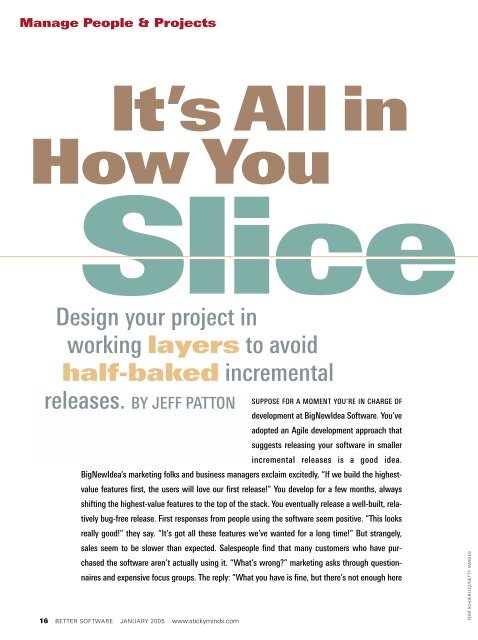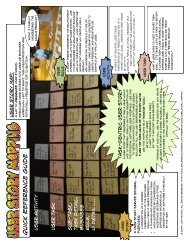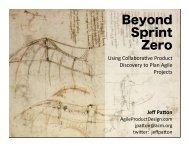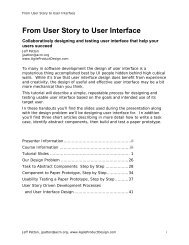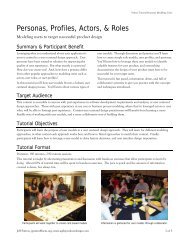How You Slice It - AgileProductDesign.com
How You Slice It - AgileProductDesign.com
How You Slice It - AgileProductDesign.com
You also want an ePaper? Increase the reach of your titles
YUMPU automatically turns print PDFs into web optimized ePapers that Google loves.
Manage People & Projects<br />
<strong>It</strong>’s All in<br />
<strong>How</strong> <strong>You</strong><br />
<strong>Slice</strong><br />
Design your project in<br />
working layers to avoid<br />
half-baked incremental<br />
releases. BY JEFF PATTON<br />
16 BETTER SOFTWARE JANUARY 2005 www.stickyminds.<strong>com</strong><br />
SUPPOSE FOR A MOMENT YOU’RE IN CHARGE OF<br />
development at BigNewIdea Software. <strong>You</strong>’ve<br />
adopted an Agile development approach that<br />
suggests releasing your software in smaller<br />
incremental releases is a good idea.<br />
BigNewIdea’s marketing folks and business managers exclaim excitedly, “If we build the highestvalue<br />
features first, the users will love our first release!” <strong>You</strong> develop for a few months, always<br />
shifting the highest-value features to the top of the stack. <strong>You</strong> eventually release a well-built, relatively<br />
bug-free release. First responses from people using the software seem positive. “This looks<br />
really good!” they say. “<strong>It</strong>’s got all these features we’ve wanted for a long time!” But strangely,<br />
sales seem to be slower than expected. Salespeople find that many customers who have purchased<br />
the software aren’t actually using it. “What’s wrong?” marketing asks through questionnaires<br />
and expensive focus groups. The reply: “What you have is fine, but there’s not enough here<br />
TOM SCHIERLITZ/GETTY IMAGES
<strong>It</strong><br />
FPO
Manage People & Projects<br />
for me to get my job done. I still have to<br />
do much of my work manually. I have to<br />
transfer information from my paperwork<br />
to the software and back again. Sometimes<br />
I can’t even figure out a paper<br />
workaround. I’ll wait for the next release<br />
to see if you get farther along.”<br />
<strong>You</strong> expected that all those high-value<br />
features would make a great product, but<br />
it turned out you needed some of those<br />
low-value features to hold everything together—to<br />
make the product useful to<br />
those trying to ac<strong>com</strong>plish work with the<br />
software. If you still want to release the<br />
software incrementally, how do you<br />
choose a first bundle of features that is<br />
both high value and immediately useful?<br />
In this article, we’ll walk through a simple,<br />
collaborative, card-based planning<br />
model that does just that.<br />
PREP WORK<br />
Before you begin, you need to choose a<br />
good cross section of folks to participate<br />
in creating the model. While the model<br />
could be prepared by one person, I<br />
wouldn’t re<strong>com</strong>mend it. Having a mix of<br />
people will help increase understanding<br />
of the software throughout the team.<br />
Choose people familiar with the users<br />
and functionality of your software, such<br />
as domain experts, testers, and user interface<br />
designers. Choose people who have<br />
some ideas on how the software will earn<br />
your <strong>com</strong>pany money—your stakeholders.<br />
Choose people who know something<br />
about how long this work will take to<br />
build—a developer or two. Four to eight<br />
[When releasing] software incrementally,<br />
how do you choose a first<br />
bundle of features that is both high value<br />
and immediately useful?<br />
Key<br />
Ingredients<br />
2–3 large sheets poster paper<br />
3–4 packs markers<br />
1 roll tape<br />
1–2 packs 3×5 index cards<br />
Plus, the fundamental element of all good<br />
meetings: food.<br />
18 BETTER SOFTWARE JANUARY 2005 www.stickyminds.<strong>com</strong><br />
people total is a good number. Use the<br />
creation of the model as an opportunity<br />
to elicit discussion about the features being<br />
built.<br />
STEP 1: COLLECT FEATURES<br />
With the prep work done, it’s time to<br />
start assembling the model. The first step<br />
is to answer the question “What does our<br />
software do?” <strong>You</strong> should start with a<br />
user-centric list of features. Depending<br />
on your situation, this<br />
might be trickier than it sounds.<br />
My definition of a good feature<br />
is one that is expressed from a<br />
user’s perspective. For example, if I<br />
were building new software for a<br />
retail store, a feature might be “sell<br />
items at point of sale” as opposed<br />
to “the system supports EAN-13<br />
barcodes.” There’s a difference<br />
there that I hope is not so subtle.<br />
The first feature describes an activity<br />
done by a person; the second<br />
describes an attribute of an object.<br />
Look for features that start with or<br />
include some action verb; that’s a<br />
good sign. When describing your software,<br />
it helps to indicate how it will be<br />
used rather than how it might look or the<br />
details of its implementation. Keeping<br />
your focus on the usefulness of the software<br />
at this stage helps to ensure that the<br />
bits of software released incrementally<br />
will be useful.<br />
If you’re not already describing features<br />
for your software in a user-centric<br />
way, you may need to spend a little time<br />
reframing your features.<br />
Write the features on 3×5 cards or on<br />
something else that you can easily move<br />
around in your model. I’ve found it’s easy<br />
to merge features originating in a spreadsheet<br />
with a word processor document<br />
that will print them on precut 3×5 cards<br />
or business cards. This way, the cards are<br />
easy to read and work well within a cardmodeling<br />
exercise. Leave room under the<br />
feature statement for the details we’ll add<br />
in Steps 2 and 3.<br />
Suppose I’m building some software<br />
for small retailers. I know that their business<br />
processes go a bit like this (notice<br />
that each one starts with an action verb):<br />
■ Create purchase order for vendor<br />
■ Receive shipment from vendor<br />
■ Create tags for received items<br />
■ Sell items<br />
■ Return and refund items<br />
■ Analyze sales<br />
STEP 2: ADD DETAILS<br />
To help you model these features, let’s<br />
note three important details on the<br />
cards: who uses the feature, how often<br />
the feature is used, and how valuable the<br />
feature is.<br />
First, for each feature, detail the kind<br />
of user who uses it. When describing this<br />
feature, you likely envisioned someone<br />
using it—who was he? <strong>You</strong> can identify<br />
him with a job title, a role name, a persona,<br />
or in any other way most appropriate<br />
for your system. (See this issue’s<br />
StickyNotes for more on roles.)<br />
Looking back at my set of retail store<br />
features, I know that the same person<br />
usually doesn’t do all this stuff. I know<br />
that the work is divided between merchandise<br />
buyers, stock receivers, customer<br />
consultants, and sales analysts. I<br />
note each user under the feature state-<br />
create po<br />
for vendor<br />
(merchandise buyer)<br />
frequency: weekly<br />
value: medium<br />
Figure 1: A <strong>com</strong>pleted feature card.
Tips for Success<br />
When assembling the batch of features for your project, pay attention<br />
to the following details to help ensure success.<br />
When using use cases, focus first on those where the actors<br />
are a single user and the system. Avoid planning with use cases<br />
that describe the internal workings of the system. Avoid use cases<br />
that describe business processes at a very high level; make<br />
them what author Alistair Cockburn calls “sea level system scope<br />
use cases.”<br />
If you’re using user stories, include a user of the feature in a<br />
concise story statement, such as the one author Mike Cohn credits<br />
practitioner Rachel Davies with inventing: As a [type of user] I<br />
want [some particular feature] so that [some benefit is received].<br />
For example: “As a bank customer I want to view my current account<br />
balance so that I know my recent deposit went through.”<br />
The <strong>com</strong>pleted model shows us features arranged in the order<br />
they’re needed by people and business processes, but this really<br />
only gives us an indication of dependence. As you slice off releases,<br />
scan each feature for dependencies that might not be in this<br />
ment he is involved with.<br />
Next, note how frequently you believe<br />
each feature will be used. <strong>You</strong> can<br />
use simple notation like high, medium, or<br />
low. I use a little more precise continuum,<br />
writing under the user on the feature<br />
card either hourly, daily, weekly, monthly,<br />
or quarterly.<br />
Finally, for each feature, note its value<br />
to the purchasers of this system. If your<br />
<strong>com</strong>pany has a good understanding of<br />
where ROI <strong>com</strong>es from on this system,<br />
this may not be too hard—but for the rest<br />
of us, this is usually a subjective judgment.<br />
Using high, medium, and low will<br />
work fine for our use today. I’ll write the<br />
value under the frequency on each card.<br />
When all of these details have been<br />
added, one of the feature cards might<br />
look like the one in Figure 1.<br />
When trying this at home, make<br />
adding these details a collaborative activity.<br />
Assuming you’ve got your features<br />
written or otherwise printed on cards,<br />
spread those cards out on the table. Take<br />
turns picking up cards and adding user,<br />
frequency, and value. If you’ve got a<br />
good mixed group, you’ll notice that<br />
some folks have strong opinions about<br />
some of these details. Some folks may<br />
know a bit about the user and frequency,<br />
but nothing about value. <strong>You</strong>’ll find with<br />
a good mixed collaborative group, you’ll<br />
be able to quickly fill in all these details.<br />
<strong>You</strong>’ll notice lots of good discussion<br />
while doing it.<br />
When writing your features on cards,<br />
the same information should appear in<br />
the same place all the time. This makes<br />
the cards easy to read when placed in the<br />
model. They might start to look like<br />
playing cards in a game. That’s good.<br />
Building the model should feel a bit like<br />
you’re playing a game.<br />
STEP 3: PLACE CARDS IN<br />
SEQUENTIAL ORDER<br />
To build this model, lay a few sheets of<br />
poster paper on a large worktable. This<br />
model is generally wide, so arrange<br />
always<br />
used<br />
Criticality<br />
seldom<br />
used<br />
Manage People & Projects<br />
release or a prior one. I’ve found that if I slice releases horizontally<br />
starting from the top of the model down, I rarely run into dependencies<br />
I haven’t already resolved in a previous release.<br />
Sometimes folks suggest features that aren’t really about users<br />
and the functionality they need. Features like “migrate to an Oracle<br />
database” or “change the look and feel to match our new branding.”<br />
These sorts of features don’t work well in this type of model.<br />
When talking about certain features, you might find it’s tough<br />
to defer some of them <strong>com</strong>pletely. When slicing off a set of features<br />
to release, discuss how usable that release will be. For each<br />
user of the system ask if she will be able to do her work with this<br />
subset of features. For each important feature left out, is there a<br />
paper process or software workaround that allows her to live<br />
without the feature—no matter how annoying that might be?<br />
Could the feature be split into a crude minimal version for earlier<br />
release and a more elaborate version for later release?<br />
See this issue’s StickyNotes for some reading that will help<br />
ensure a good out<strong>com</strong>e.<br />
sheets and tape them together to form a<br />
broad poster.<br />
Draw a horizontal line across the top<br />
of the page and label it usage sequence.<br />
Draw a line on the left side of the<br />
page from top to bottom and label it criticality.<br />
Label the top endpoint of this line<br />
always used, the bottom endpoint seldom<br />
used. The resulting diagram should<br />
look like the one in Figure 2.<br />
<strong>You</strong> now need to place features in the<br />
model according to usage sequence and<br />
criticality. By using the features we wrote<br />
out for our retail software earlier, we’ve<br />
already listed them in the order the features<br />
will be used. PO creation happens<br />
before shipments are received from the<br />
vendor. Tags are created before the items<br />
are put on the shelf and sold. Sales are<br />
Usage Sequence<br />
Figure 2: The model starts with an x and a y axis.<br />
www.stickyminds.<strong>com</strong> JANUARY 2005 BETTER SOFTWARE 19
Manage People & Projects<br />
analyzed after some items are sold.<br />
That’s what I mean by usage sequence.<br />
In reality, it may not seem so cut and<br />
dried. If we really look at a retail store,<br />
we might find buyers on the phone placing<br />
orders at the same time receiving<br />
clerks are in the back room receiving and<br />
tagging. If the store’s open, we hope customers<br />
will be on the retail floor happily<br />
buying our products and customer consultants<br />
will be ringing them up. <strong>It</strong> looks<br />
like all these features are being used simultaneously<br />
and indeed they are. So<br />
when sequencing them in your model,<br />
arrange them in the order that seems logical<br />
when explaining to others the business<br />
process. If you explain the business<br />
process starting with the selling part,<br />
that’s OK, put that feature first. We want<br />
this model to help us tell stories about<br />
our software, so arrange them in an order<br />
that makes it easy to tell stories.<br />
Distribute the cards among participants.<br />
Then have everyone, in as orderly<br />
always<br />
used<br />
Criticality<br />
seldom<br />
used<br />
create po<br />
for vendor<br />
(merchandise buyer)<br />
frequency: weekly<br />
value: medium<br />
receive shipment<br />
from vendor<br />
(stock receiver)<br />
frequency: daily<br />
value: high<br />
a manner as possible, place the cards in<br />
your model by usage sequence, with features<br />
used early on the left and later on<br />
the right. Have them overlap features<br />
that might happen at about the same<br />
point in time. If someone gets confused<br />
about the position of a feature, suggest<br />
In reality, it may not seem so cut and<br />
dried. . . . <strong>It</strong> looks like all these features<br />
are being used simultaneously<br />
and indeed they are.<br />
that he look at the feature and its immediate<br />
neighbors. <strong>It</strong>’s sometimes easier to<br />
answer the question “does this happen<br />
before that” than to try to take everything<br />
into account at once.<br />
If we arranged our feature cards in sequence,<br />
it might look a bit like the diagram<br />
in Figure 3.<br />
STEP 4: GROUP BY<br />
FREQUENCY<br />
For each of these features, how critical to<br />
our business is it that someone actually<br />
uses it? Let’s look at our retail features:<br />
When working with the business people<br />
who know how their business is run,<br />
they inform us that orders often are<br />
Usage Sequence<br />
create tags for<br />
received items<br />
(stock receiver)<br />
frequency: daily<br />
value: medium<br />
Figure 3: The features cards are first arranged by sequence.<br />
always<br />
used<br />
Criticality<br />
seldom<br />
used<br />
create po<br />
for vendor<br />
(merchandise buyer)<br />
frequency: weekly<br />
value: medium<br />
receive shipment<br />
from vendor<br />
(stock receiver)<br />
frequency: daily<br />
value: high<br />
Usage Sequence<br />
create tags for<br />
received items<br />
(stock receiver)<br />
frequency: daily<br />
value: medium<br />
sell items analyze sales<br />
(customer consultant) (sales analyst)<br />
frequency: hourly frequency: monthly<br />
value: high<br />
value: high<br />
return and<br />
refund items<br />
(customer consultant)<br />
frequency: daily<br />
value: medium<br />
sell items<br />
(customer consultant)<br />
frequency: hourly<br />
value: high<br />
return and<br />
refund items<br />
(customer consultant)<br />
frequency: daily<br />
value: medium<br />
analyze sales<br />
(sales analyst)<br />
frequency: monthly<br />
value: high<br />
Figure 4: The sequential feature cards are then staggered according to criticality.<br />
20 BETTER SOFTWARE JANUARY 2005 www.stickyminds.<strong>com</strong><br />
placed with vendors informally over the<br />
phone without a purchase order being<br />
created in the system. So in those cases,<br />
we’ll receive the items into inventory<br />
without a PO. This is generally the exception,<br />
but it happens and should be<br />
supported. So our feature “create PO for<br />
vendor” is important to our system and<br />
is used frequently, but not always.<br />
As a group, adjust vertical positioning<br />
of your cards based on how critical they<br />
are to the business process. If the feature<br />
is always done, place it on the top. If the<br />
feature is often —but not always—done,<br />
place it a bit below the top line. If it’s seldom<br />
done, place it toward the bottom. If<br />
you’ve got enough people working on<br />
the model simultaneously, this may start<br />
to look like a game of Twister. <strong>You</strong>’ll observe<br />
people moving cards down only to<br />
see them adjusted back up by someone<br />
else. Use these conflicting card movements<br />
to elicit discussions on why someone<br />
might believe a particular feature is<br />
more critical than another feature.<br />
If we adjust our features for criticality,<br />
our model might look a bit like the one<br />
in Figure 4.<br />
STEP 5: NOTE LOGICAL<br />
BREAKS IN WORKFLOW<br />
If your system is anything like those I’ve<br />
worked on, you’ll have knitted together a<br />
few distinct processes done by different<br />
people at different times. When you look<br />
across your model from left to right, you<br />
might start to see logical breaks in the<br />
workflow. Remember how for each feature<br />
you noted a type of user or role that<br />
primarily used the feature? <strong>You</strong>’ll find<br />
that these breaks often occur when there’s<br />
a role change. Reading left to right you’ll<br />
see some features are used by one role,<br />
then you’ll see a change to another role<br />
with some features used by this next role.<br />
As a group, discuss where you see<br />
breaks or pauses in the business process.<br />
Then, at each break draw a vertical line,<br />
dividing the model into something that<br />
looks a bit like swim lanes. Label the resulting<br />
columns for each process as<br />
shown in Figure 5. If you’re finding it<br />
hard to divide the model in this way, discuss<br />
why. Is there really only one type of<br />
user doing one process? Or, do we have<br />
different user’s features mixed up in the<br />
same timeline?
page 21<br />
full-page ad<br />
SQE
Manage People & Projects<br />
This is all quite interesting so far, but<br />
what are you learning about how to<br />
build releases for your software? Let’s<br />
take a closer look.<br />
STEP 6: MARK THE FIRST<br />
SYSTEM SPAN<br />
Now we’re going to divide the model<br />
into what I call system spans. (The Poppendiecks<br />
introduced me to the term<br />
“span” in their book Lean Software Development.)<br />
A system span is a set of features<br />
that group together logically and<br />
that cut through the business processes<br />
horizontally from start to finish.<br />
The first span should be the smallest<br />
set of features necessary to be minimally<br />
useful in a business context. In our model,<br />
it turns out that the very top row (receiving<br />
and selling items) is the first, most<br />
minimal system span. This will be true of<br />
your model, too. Draw a line under the<br />
top row of your model to indicate the<br />
features that make up this first system<br />
span, as shown in Figure 6.<br />
The first span represents the most<br />
concise set of features that tunnel<br />
through the system’s functionality from<br />
end to end—the bare bones minimum<br />
anyone could legitimately do and still<br />
use the system. This small span should<br />
always be your first release, but it need<br />
not be the first public release of your<br />
software. Getting this part <strong>com</strong>pleted<br />
and released, even if only to internal test<br />
environments, forces resolution of both<br />
the functional and technical framework<br />
of your application. <strong>You</strong>r testers will be<br />
able to see if the application hangs together<br />
coherently. <strong>You</strong>r architects will<br />
be able to validate the tech-stack func-<br />
tions as expected and may begin working<br />
on load tests to validate scalability.<br />
The team can begin to relax knowing<br />
that from here on in they’re adding<br />
more features to a system that can be released<br />
and likely used.<br />
Notice how in the example we’ve not<br />
always<br />
used<br />
create po<br />
for vendor<br />
(merchandise buyer)<br />
frequency: weekly<br />
value: medium<br />
22 BETTER SOFTWARE JANUARY 2005 www.stickyminds.<strong>com</strong><br />
Criticality<br />
seldom<br />
used<br />
receive shipment<br />
from vendor<br />
(stock receiver)<br />
frequency: daily<br />
value: high<br />
built any functionality to support the<br />
merchandise buyer or the sales analyst.<br />
Ultimately, we know that supporting<br />
those folks with some functionality is important.<br />
But, because the work they’re<br />
doing doesn’t always happen, we can defer<br />
it at least for a little while.<br />
After drawing the line in your model<br />
are there roles and business processes<br />
that are omitted? Talk about them as a<br />
group.<br />
STEP 7: FILL IN BUILD<br />
ESTIMATES<br />
OK, so building a first span is a good<br />
idea, but how long will it take? If you’ve<br />
got developers participating in this exercise,<br />
and you should, this is a good time<br />
for them to start giving development estimates<br />
for each feature. Write the time<br />
estimates in days or weeks directly on<br />
the cards. Very rough estimates will do<br />
fine. Developers may find that seeing<br />
Usage Sequence<br />
BUYING RECEIVING SELLING ANALYZING<br />
create tags for<br />
received items<br />
(stock receiver)<br />
frequency: daily<br />
value: medium<br />
sell items<br />
(customer consultant)<br />
frequency: hourly<br />
value: high<br />
return and<br />
refund items<br />
(customer consultant)<br />
frequency: daily<br />
value: medium<br />
Figure 5: The model is vertically divided into business processes.<br />
always<br />
used<br />
Criticality<br />
seldom<br />
used<br />
create po<br />
for vendor<br />
(merchandise buyer)<br />
frequency: weekly<br />
value: medium<br />
receive shipment<br />
from vendor<br />
(stock receiver)<br />
frequency: daily<br />
value: high<br />
A system span is a set of features that<br />
group together logically<br />
and that cut through the business<br />
processes horizontally from start to finish.<br />
Usage Sequence<br />
create tags for<br />
received items<br />
(stock receiver)<br />
frequency: daily<br />
value: medium<br />
sell items<br />
(customer consultant)<br />
frequency: hourly<br />
value: high<br />
return and<br />
refund items<br />
(customer consultant)<br />
frequency: daily<br />
value: medium<br />
analyze sales<br />
(sales analyst)<br />
frequency: monthly<br />
value: high<br />
BUYING RECEIVING SELLING ANALYZING<br />
System Span<br />
analyze sales<br />
(sales analyst)<br />
frequency: monthly<br />
value: high<br />
Figure 6: The first system span represents the smallest set of features necessary to<br />
be minimally useful in a business context.<br />
the “big picture” helps them estimate a<br />
little better. (See this issue’s StickyNotes<br />
for more guidance on quick estimation<br />
techniques.)<br />
Once you have rough estimates, add<br />
up the estimates for the features above<br />
the line marking the first span. This is<br />
how long it should take to build.<br />
STEP 8: SLICE AND SERVE<br />
The plan may now be “sliced” horizontally<br />
into subsequent system spans, or<br />
spanning releases. Well, sort of horizontally.<br />
Choose features below the marked<br />
first span that group together logically.<br />
Choose enough features such that the<br />
estimated elapsed development days fit<br />
within an appropriate release date. This<br />
may cause you to draw lines that wander<br />
up and down to catch and miss features<br />
while traversing the model from<br />
left to right. Lines drawn through the<br />
plan make it start to look like a haphazard<br />
layer cake.<br />
At this point in the collaborative activity,<br />
the business people responsible<br />
for the release should step forward. Let<br />
them use their best judgment to decide<br />
what features best make up a release. If<br />
you’re an observer, ask questions so you<br />
understand why one feature rather than<br />
(Continued on page 40)
page 23<br />
full-page ad<br />
SPI Dynamics
Manage People & Projects<br />
(Continued from page 22)<br />
another finds its way into an earlier release.<br />
Responsible business people continue<br />
to slice your “cake” into appropriate releases.<br />
When choosing features to fill a<br />
release, you may want to consider the<br />
features with the highest value first. <strong>You</strong><br />
may also want to consider building up<br />
support for a particular type of user or<br />
business process. In a release, you might<br />
try <strong>com</strong>pleting all the valuable features in<br />
one of your business process columns.<br />
This will result in some funny-shaped<br />
lines stretching from left to right.<br />
After slicing the model into releases,<br />
you should be able to see how many releases<br />
it will take to build this software<br />
and what might be contained in each<br />
release.<br />
Now, let’s get real. Most software<br />
worth writing has more than six features.<br />
Depending on the granularity of your<br />
features, you’ll likely have dozens. With<br />
a reasonable number of features your<br />
plan will likely look like the photo<br />
1/3<br />
square<br />
left<br />
Rally<br />
shown in Figure 7. Notice in this model<br />
that software spans several business<br />
processes. Notice how the releases cut<br />
from left to right in some funny jagged<br />
lines that catch the features the planner<br />
intended for each release.<br />
40 BETTER SOFTWARE JANUARY 2005 www.stickyminds.<strong>com</strong><br />
hi-res<br />
TK<br />
Figure 7: A real-life model is much more <strong>com</strong>plex and spans several business<br />
processes.<br />
THE RESULTS<br />
Because you’ve arranged features in sequential<br />
order, you now understand what<br />
features depend on one another. Because<br />
you’ve arranged them by criticality, the<br />
important features are now emphasized<br />
at the top of the plan. Because you’ve divided<br />
the features into business processes,<br />
you have a better idea of the functionality<br />
that supports each major business<br />
process in your software. <strong>You</strong> have determined<br />
the minimal feature span that lets<br />
you get your system up and running, end<br />
to end, as soon as possible. All this information<br />
is provided in one convenient picture.<br />
By employing a little <strong>com</strong>mon<br />
sense, we should be able to carve off the<br />
smallest possible releases that will still be<br />
useful to the people who ultimately receive<br />
those releases.<br />
Incremental release may be one of the<br />
more valuable aspects of the various Agile<br />
development methodologies. An early<br />
release can help capture market share,<br />
generate early return on investment, and<br />
reduce money risked on software development.<br />
A strong early release can increase<br />
those benefits immensely. The<br />
model we’ve built can give you a better<br />
picture of your software’s features and<br />
help your organization construct the<br />
most useful and coherent early release<br />
possible. {end}<br />
Jeff Patton leads teams of Agile developers<br />
to build the best software possible.<br />
He proudly works at ThoughtWorks.


